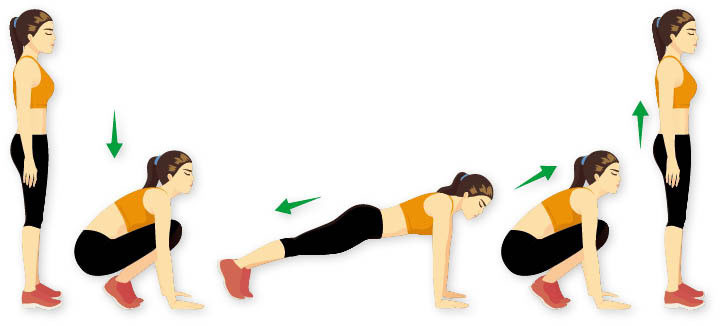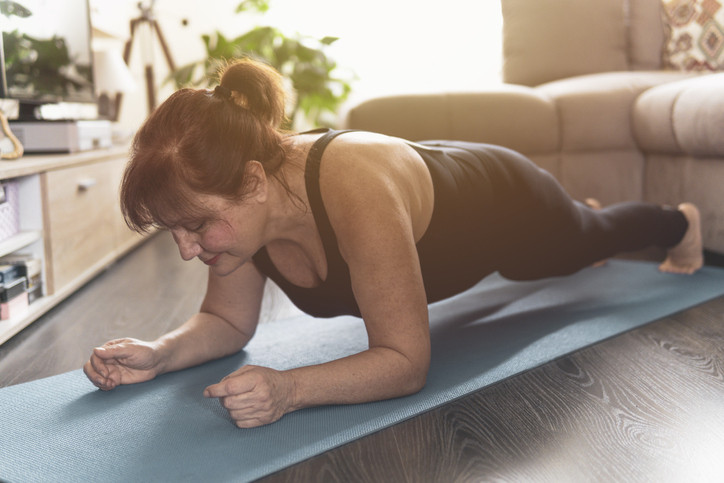Exercise challenge: Part 3
Get stronger by adding more exercises that are more challenging to your weekly routine.
In our May and August issues, Dr. Beth Frates, clinical assistant professor of physical medicine and rehabilitation at Harvard Medical School, recommended a set of six of exercises to help you start building your muscle strength. If you’ve been doing these exercises over the past few months, you may be ready for a new workout to help you continue your progress.
Like the first two batches of exercises, this new group is designed to work a combination of muscles in your arms, legs, and core.
Ideally, you should perform these exercises at least twice a week. You can add them to your weekly workout plan by either swapping them entirely for the first or second batch of exercises from the earlier issues, or by incorporating some of the exercises from the first two groups one day a week and this group on a second (nonconsecutive) day, says Dr. Frates.
If you have time and want a more vigorous workout, add these new exercises to the push-up exercise from the May issue.
Test your progress with the push-up testYour ability to do push-ups is a good indicator of muscle strength. If you can do 10 to 15 push-ups, you’re in good shape. You are in excellent shape if you can do 16 or more. |
Plank with arm extension

In the May and August issues, Dr. Frates recommended two variations on the plank exercise — a traditional plank and a side plank — to help you build upper-body and core strength. This time try a third option: a plank with one arm extended in front of you, which works slightly different muscle groups. To do this exercise, get into the plank position, either with your legs straight, supporting yourself on the balls of your feet, or resting on your knees. Hold the plank position and slowly extend one arm forward, straight out in front of you. Then slowly move the arm back down and lift your other arm.
Set a goal: Test yourself to see how many you can do, and build from there. Try to achieve five arm extensions on each side. Over the next few months, build up to three full sets of 10 (five on each side).
Burpee

A burpee is a challenging exercise that works muscles in your legs and core. To begin, stand with your feet together and your arms at your sides. Squat down and place your hands on the floor. Jump to extend your legs back so you are in a push-up position. Jump again to bring your feet back to a squatting position. Then jump into the air, landing in the starting position. Repeat. Be certain to keep your head and neck in line with your spine and keep your abdominal muscles tight. If this version of the exercise is too challenging, try a modified burpee instead. Rather than jumping between the squat and the push-up position, walk your feet out and in, and don’t jump as high in the last step.
Set a goal: First, see how many burpees you can do and whether you need to try the modified version instead. Depending on your current fitness level, you can begin with as little as one set of five repetitions, or one set of 10. Then, over the next few months, gradually work your way up to three sets of 10 burpees per workout session.
Sit-to-stand
This exercise is a great way to build strength and also improve your balance. Cross your legs, then squat as low as you can and stand up. Over time, try to get lower and lower on the squat until you can sit on the floor. Now try to stand up without using your hands or putting your knees on the ground.
Set a goal: When performing this exercise, use caution or have someone stand nearby to spot you. It’s very challenging. Gauge your skill by testing whether you can perform the exercise without using your hand, knee, or forearm or losing your balance.
Image: © solar22/Getty ImagesAbout the Author

Kelly Bilodeau, Former Executive Editor, Harvard Women's Health Watch
Disclaimer:
As a service to our readers, Harvard Health Publishing provides access to our library of archived content. Please note the date of last review or update on all articles.
No content on this site, regardless of date, should ever be used as a substitute for direct medical advice from your doctor or other qualified clinician.














